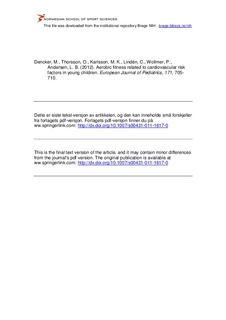| dc.contributor.author | Dencker, Magnus | |
| dc.contributor.author | Thorsson, Ola | |
| dc.contributor.author | Karlsson, Magnus K. | |
| dc.contributor.author | Lindén, Christian | |
| dc.contributor.author | Wollmer, Per | |
| dc.contributor.author | Andersen, Lars Bo | |
| dc.date.accessioned | 2012-12-04T08:49:33Z | |
| dc.date.available | 2012-12-04T08:49:33Z | |
| dc.date.issued | 2011-12-13 | |
| dc.identifier | Seksjon for idrettsmedisinske fag / Department of Sports Medicine | |
| dc.identifier.citation | European Journal of Pediatrics. 2012, 171, 705-710 | no_NO |
| dc.identifier.issn | 0340-6199 | |
| dc.identifier.uri | http://hdl.handle.net/11250/171080 | |
| dc.description | I Brage finner du siste tekst-versjon av artikkelen, og den kan inneholde ubetydelige forskjeller fra forlagets pdf-versjon. Forlagets pdf-versjon finner du på www.springerlink.com: http://dx.doi.org/10.1007/s00431-011-1617-0 / In Brage you'll find the final text version of the article, and it may contain insignificant differences from the journal's pdf version. The original publication is available at www.springerlink.com: http://dx.doi.org/10.1007/s00431-011-1617-0 | no_NO |
| dc.description.abstract | Low aerobic fitness (maximum oxygen uptake
(VO2PEAK)) is predictive for poor health in adults. In a
cross-sectional study, we assessed if VO2PEAK is related to
a composite risk factor score for cardiovascular disease
(CVD) in 243 children (136 boys and 107 girls) aged 8 to
11 years. VO2PEAK was assessed by indirect calorimetry
during a maximal exercise test and scaled by body mass
(milliliters per minute per kilogram). Total body fat mass
(TBF) and abdominal fat mass (AFM) were measured by
Dual-energy X-ray absorptiometry. Total body fat was
expressed as a percentage of total body mass (BF%) and
body fat distribution as AFM/TBF. Systolic and diastolic
blood pressure (SDP and DBP) and resting heart rate
(RHR) were measured. The mean artery pressure (MAP)
and pulse pressure (PP) were calculated. Echocardiography,
2D-guided M-mode, was performed. Left atrial diameter
(LA) was measured and left ventricular mass (LVM) and
relative wall thickness (RWT) were calculated. Z scores
(value for the individual − mean value for group)/SD were
calculated by sex. The sum of z scores for DBP, SDP, PP,
MAP, RHR, LVM, LA, RWT, BF%, AFM and AFM/TBF
were calculated in boys and girls, separately, and used as
composite risk factor score for CVD. Pearson correlation
revealed significant associations between VO2PEAK and
composite risk factor score in both boys (r=−0.48 P<0.05)
and in girls (r=−0.42, P<0.05). One-way ANOVA analysis
indicated significant differences in composite risk factor
score between the different quartiles of VO2PEAK (P<
0.001); thus, higher VO2PEAK was associated with lower
composite risk factor score for CVD. In conclusion, low
VO2PEAK is associated with an elevated composite risk
factor score for CVD in both young boys and girls. | no_NO |
| dc.language.iso | eng | no_NO |
| dc.publisher | Springer Verlag | no_NO |
| dc.subject | VO2PEAK | no_NO |
| dc.subject | body fat | no_NO |
| dc.subject | DXA | no_NO |
| dc.subject | CVD risk factors | no_NO |
| dc.title | Aerobic fitness related to cardiovascular risk factors in young children | no_NO |
| dc.type | Journal article | no_NO |
| dc.type | Peer reviewed | no_NO |
| dc.subject.nsi | VDP::Medical disciplines: 700 | no_NO |
| dc.source.pagenumber | 705-710 | no_NO |
| dc.source.volume | 171 | no_NO |
| dc.source.journal | European Journal of Pediatrics | no_NO |
| dc.source.issue | 4 | no_NO |
